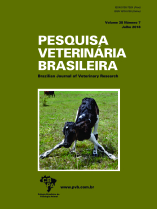 |
|
|
|
Year 2018 - Volume 38, Number 7
|

|
Serological study on Corynebacterium pseudotuberculosis infection in goats in the Brazilian Northeast using enzyme-linked immunosorbent assay (ELISA-indirect), 38(7):1344-1350
|
ABSTRACT.- Farias A.M., Alves J.R.A., Alves F.S.F., Pinheiro R.R., Faccioli-Martins P.Y., Lima A.M.C., Azevedo S.S. & Alves C.J. 2018. [Serological study on Corynebacterium pseudotuberculosis infection in goats in the Brazilian Northeast using enzyme-linked immunosorbent assay (ELISA-indirect)] Estudo sorológico sobre infecção por Corynebacterium pseudotuberulosis em caprinos no Nordeste brasileiro utilizando técnica de imunoabsorção enzimática (ELISA-indireto). Pesquisa Veterinária Brasileira 38(7):1344-1350. Programa de Pós-Graduação em Medicina Veterinária, Universidade Federal de Campina Grande, Av. Universitária s/n, Santa Cecília, Patos, PB 58700-970, Brasil. E-mail: clebertja@uol.com.br
Goat farming in the Northeast region of Brazil plays an important socioeconomic and strategic role. The rusticity of this activity in this region, allied with its rapid expansion in other states, has caused losses in its production chain in regional and national levels, caused by infectious diseases, especially caseous lymphadenitis (CL), a widespread goat herds disease which has been causing serious economic loss to this activity. Although CL has been detected as an endemic problem in the Brazilian Northeast, a comprehensive and more recent analysis of this prevalence in Brazilian goats is necessary. The objective of this study was to determine the frequency of anti-Corynebacterium pseudotuberculosis antibodies in five of nine states of the northeast region of Brazil. Serum samples were collected from 2571 goats from 218 farms in five states in the Northeast region of Brazil, collected between 2010 and 2012. The diagnosis of C. pseudotuberculosis infection was made using the ELISA-indirect technique. In 88.5% (193/218) of the investigated properties, at least one goat was seropositive for C. pseudotuberculosis, suggesting that the agent is widespread in Northeast herds, with the highest prevalence found in Rio Grande do Norte (94.5%) and the lowest one in the state of Sergipe (70.3%). A total of 783 (30.45%; 95% CI = 28.71-32.26%) seropositive goats were found, and the highest prevalence among animals was found in Piauí (41.4%) and the lowest in the state of Sergipe (22.5%). Out of a total of 279 breeding herds, 106 (37.99%) were seropositive, standing out the Rio Grande do Norte, with a total of 45.30%, and Piauí 46.8% of positive breeding for CL. A total of the 1420 tested matrices, 599 (42.1%) presented positive serology for C. pseudotuberculosis. Among the States, this distribution also remained similar, standing out Rio Grande do Norte with 47.5%, and Piauí with 59.5% of positive matrices for CL. Among 872 young goats evaluated, 78 (8.9%) were seropositive for CL, observing a statistical difference in the frequency of soropositivity obtained between adults and young adults (P<0.001). The necessity to diagnose the disease in goat herds in the Northeast region is reinforced for the possible implementation of disease control programs and more precise measures to manage CL along with goat farmers. |
| |
|
|
| |
|
 |